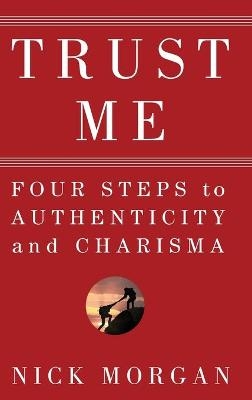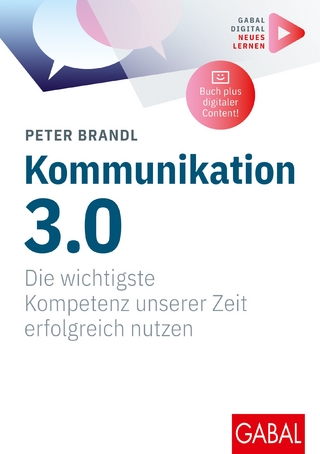
Trust Me
Jossey-Bass Inc.,U.S. (Verlag)
978-0-470-40435-5 (ISBN)
Nick Morgan shows how anyone can be an effective speaker by presenting an image of authenticity and respect for their audience, whether in a group presentation or a one-on-one conversation. He presents a four-step process, perfected in his teaching at Harvard, that enables the reader to use their own personal speaking style while becoming a more persuasive and charismatic communicator and leader. The basis of this process is the fact that when words and body language are in conflict, body language wins every time. This isn't easy to overcome, because normally body language is immediate, while the words lag slightly behind, and even a momentary conflict is perceptible to the audience. The key to success is to train your body language to unconsciously align with your message. The four steps:
Form the attitude and intent to be open, and then let your body naturally express that intent. This feeling of openness will naturally affect the content of what you are saying, and it's that natural evolution that is at the heart of the process.
Become connected to your audience. This creates a mutual energy, and you will naturally begin to think in terms of what the audience wants and needs in shaping your content.
Ask yourself, what's my underlying emotion? Why does this matter to me? Becoming passionate about what you have to say naturally makes your audience care about it too.
Really listen to the audience. Understanding their needs and reactions will enable you to direct your communication in mutually beneficial ways.
THE AUTHOR NICK MORGAN, founder of Public Words Inc., is one of America’s top communication and speech coaches. He is a former Fellow at Harvard’s Kennedy School of Government, affiliated with the Center for Public Leadership, and served as editor of the Harvard Management Communication Letter. He is the author of the acclaimed book Working the Room, reprinted in paperback as Give Your Speech, Change the World.
Introduction 1
Every communication is both a verbal and a nonverbal conversation
We are all unconscious experts in each other’s body language
1 Leaders Need Both Charisma and Authenticity 7
You need charisma and authenticity to lead effectively
Gesture can convey meaning independent of words
Our most important dialogues with others take place nonverbally
2 Aligning the Two Conversations Will Make You a Powerful Communicator 21
Communications that align both the content and the nonverbal conversations can be powerful
We unconsciously ascribe intent to the gestures we see
The paradox of leadership today is that you have to practice to look spontaneous
3 Being Open, Part One: How to Master the Verbal Conversation 35
The verbal aspect of openness involves clarity of intent
The content of an open communication begins with clear framing
To conclude an open communication, reach agreement about what has been said
4 Being Open, Part Two: How to Master the Nonverbal Conversation 43
Trust is the essential goal of an open, nonverbal conversation
When you communicate, you create a persona that other people unconsciously decode
If you work on the conscious control of intention, your gestures take care of themselves
5 Being Connected, Part One: How to Master the Verbal Connection 59
Connected communication deals with the audience’s concerns
Connected communication is direct and simple
Connected communication is reciprocal
6 Being Connected, Part Two: How to Master the Nonverbal Connection 71
Connection is first and foremost about closeness
Everything significant between people happens in personal space or intimate space
You can signal your intent with your posture
7 How to Be Passionate with Content 79
Label the emotion
Tell an uncomfortable truth
Verbal restraint can be a more powerful indicator of depth of feeling than excess
8 How to Be Passionate Nonverbally 93
The first place people look to find passion is in the voice
A good voice needs resonance and presence
Focus on your emotional attitude toward your meeting, topic, or event
9 Listening, Part One: How to Listen Verbally — and Charismatically 101
At its most basic, good listening offers feedback
The most powerful kind of listening is empathic and analytical
Identify the emotion and state its underlying causes without trying to solve the problem
10 Listening, Part Two: How to Listen Nonverbally — and Charismatically 111
Listen with your whole body
Listening is at the heart of real charisma
You must learn to read others’ emotions consciously
11 How to Read Others 121
Openness is expressed through the face and torso
Your unconscious evaluation will be more accurate than your conscious one (at fi rst)
Look for overall body orientation to determine the state of your alliances
12 Principles of Persuasive Content 143
Phrase your arguments so that your listeners can hear them
Persuasive rhetoric has a clear goal in mind and is usually transparent about it
Authenticity and charisma in content require self-revelation in a confessional age
13 Principles of Persuasive Nonverbal Communication 161
If the two conversations are aligned, you can be an effective communicator
Decision making is largely an emotional, and therefore a nonverbal, process
Authenticity and charisma derive from becoming open, connected, passionate, and listening with and to your audience
14 Conclusion: Leadership Is Communication 173
Control your body language by controlling your intent
Watch for unconscious betrayals through your body language
Repetition is the key to the unconscious
Notes 189
Acknowledgments 197
The Author 199
Index 201
| Verlagsort | New York |
|---|---|
| Sprache | englisch |
| Maße | 152 x 231 mm |
| Gewicht | 340 g |
| Themenwelt | Sachbuch/Ratgeber ► Beruf / Finanzen / Recht / Wirtschaft ► Briefe / Präsentation / Rhetorik |
| Wirtschaft ► Betriebswirtschaft / Management | |
| ISBN-10 | 0-470-40435-3 / 0470404353 |
| ISBN-13 | 978-0-470-40435-5 / 9780470404355 |
| Zustand | Neuware |
| Haben Sie eine Frage zum Produkt? |
aus dem Bereich


